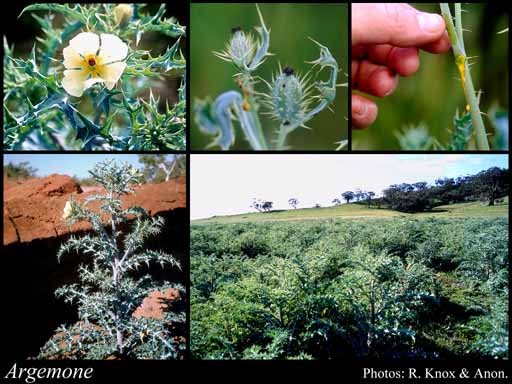- Reference
- Sp.Pl. [Linnaeus] 2:508 (1753)
- Name Status
- Current







Scientific Description
Family Papaveraceae.
Habit and leaf form. Herbs, or shrubs (rarely); with coloured juice (the juice yellow, or orange). Plants spiny, or unarmed. Annual to perennial; plants with a basal concentration of leaves. Mesophytic. Leaves alternate; spiral; petiolate (in the basal rosette), or sessile (above); non-sheathing; simple. Leaf blades dissected; pinnatifid, or much-divided (bipinnatisect, with lobes and teeth spine-tipped); pinnately veined; cross-venulate. Leaves without stipules; without a persistent basal meristem. Leaf anatomy. Hydathodes present, or absent. Stem anatomy. Nodes unilacunar, or tri-lacunar. Secondary thickening absent, or developing from a conventional cambial ring.
Reproductive type, pollination. Fertile flowers hermaphrodite. Unisexual flowers absent. Plants hermaphrodite. Entomophilous.
Inflorescence and flower features. Flowers solitary; medium-sized; operculate (calyptrate), or not operculate; odourless; (2–)3 merous; tetracyclic to pentacyclic to polycyclic. Floral receptacle developing an androphore, or developing a gynophore, or with neither androphore nor gynophore. Free hypanthium absent. Hypogynous disk absent. Perianth with distinct calyx and corolla; 6–7, or 9; 3 -whorled; isomerous, or anisomerous. Calyx (2–)3; 1 -whorled; polysepalous; imbricate; unequal but not bilabiate, or regular (? rather asymmetrical); with mucron or horn-like appendages, bristly; not persistent (caducous). Corolla 4, or 6; 2 -whorled (2+2 or 3+3); polypetalous; imbricate and crumpled in bud; regular; white, or cream, or yellow, or orange, or purple; not spurred. Androecium 50–100 (i.e. ‘many’). Androecial sequence determinable, or not determinable. Androecial members maturing centripetally; free of the perianth; free of one another; 3–15 -whorled (? generally indefinite in 2- or 3-merous, regularly alternating whorls). Androecium exclusively of fertile stamens. Stamens 50–100 (i.e. ‘many’); polystemonous. Anthers basifixed; non-versatile; dehiscing via longitudinal slits; tetrasporangiate. Gynoecium 3–7 carpelled. The pistil 1 celled. Carpels isomerous with the perianth, or increased in number relative to the perianth. Gynoecium syncarpous; synstylovarious to eu-syncarpous (depending on interpretation of confluent stigmas); superior. Ovary unilocular; 1 locular. Locules secondarily divided by ‘false septa’, or without ‘false septa’. Gynoecium stylate. Styles very short, with 3–7 free, spreading stigmatic branches; persistent. Stigmas 3–7 (the stigmas lying in a depression running along the centre of the branches); dorsal to the carpels, or commissural, or dorsal to the carpels and commissural; 1 - lobed; dry type; papillate; Group II type. Placentation parietal. Ovules in the single cavity 20–50 (i.e. ‘many’); horizontal, or ascending; with superior or lateral raphe; arillate, or non-arillate; anatropous, or campylotropous, or amphitropous.
Fruit and seed features. Fruit non-fleshy; spinose; dehiscent; a capsule (ellipsoid). Capsules valvular (dehiscing by basipetal valves to up to 1/3 of total length, rarely almost towards the base). Fruit many seeded. Seeds globose; copiously endospermic. Endosperm oily. Embryo rudimentary at the time of seed release, or weakly differentiated. Cotyledons 2. Seedling. Germination phanerocotylar, or cryptocotylar.
Physiology, biochemistry. Aluminium accumulation not found. Photosynthetic pathway: C3.
Geography, cytology, number of species. Adventive. Australian states and territories: Western Australia, South Australia, New South Wales, and Victoria. South-West Botanical Province.
Economic uses, etc. Cultivated as ornamentals.
Taxonomic Literature
- Grieve, B. J.; Blackall, W. E. 1998. How to know Western Australian wildflowers : a key to the flora of the extratropical regions of Western Australia. Part II, Dicotyledons (Amaranthaceae to Lythraceae). University of W.A. Press.. Nedlands, W.A..
- Marchant, N. G.; Wheeler, J. R.; Rye, B. L.; Bennett, E. M.; Lander, N. S.; Macfarlane, T. D.; Western Australian Herbarium 1987. Flora of the Perth region. Part one. Western Australian Herbarium.. [Perth]..